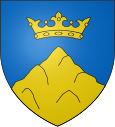Montréal (Gers)
| Montréal | ||
|---|---|---|

|
|
|
| region | Occitania | |
| Department | Gers | |
| Arrondissement | Condom | |
| Canton | Armagnac-Ténarèze | |
| Community association | Ténarèze | |
| Coordinates | 43 ° 57 ' N , 0 ° 12' E | |
| height | 73-183 m | |
| surface | 63.05 km 2 | |
| Residents | 1,168 (January 1, 2017) | |
| Population density | 19 inhabitants / km 2 | |
| Post Code | 32250 | |
| INSEE code | 32290 | |
| Website | www.montrealdugers.fr | |
 Saints-Philippe-et-Jacques church |
||
Montréal or Montreal-du-Gers is a French commune in the department of Gers in the region Occitania . The municipality with 1168 inhabitants (as of January 1, 2017) belongs to the canton of Armagnac-Ténarèze and was the capital of the canton of the same name until 2015 . The long-distance hiking trail GR 65 leads through the village , which largely follows the historical course of the French Way of St. James, Via Podiensis .
Montréal has been named one of the most beautiful villages in France by the association Les plus beaux villages de France .
geography
The municipality is located in the historical region of Armagnac in the heart of Gascony , which is world famous for the Armagnac brandy it produces . The place is on a hill above the Auzoue river , which flows into the Garonne via the Gélise and Baïse .
The next larger town is Agen , which can be reached in a north-easterly direction via the D15 - D931 route after about 55 kilometers of road. The nearby French cities are Toulouse in the southeast (107 km) and Bordeaux in the northwest (117 km).
history
The place arose on the site of a Roman oppidum . It was founded by Alphonse de Poitiers on March 30, 1255 , as one of the first fortified fortified villages ( bastide ) in Gascony . Alphonse de Poitiers became lord of the county of Toulouse and Agen through his marriage in 1229 to Johanna , a daughter of Count Raymond VII . After both perished in Italy on the way back from the Seventh Crusade in 1271 without leaving any descendants, Montréal, like the rest of Languedoc , falls to the French King Philip the Bold . Around 1320, Montréal, like many other cities in the region, is attached to the Duchy of Guyenne , which is owned by the English crown. As a result, the place was besieged in 1350, during the Hundred Years War , by Charles the Evil , King of Navarre . 1368 the place of the French king, was Charles V. , the Duke of Armagnac passed.
During the Huguenot Wars , Montréal changed hands several times, with the Saint Orens basilica and the site being largely destroyed by Protestant troops, led by Count Montgomery . The basilica was not rebuilt until the 17th century and the town center with the market square was not restored until the 19th century.
| year | 1806 | 1841 | 1886 | 1901 | 1921 | 1936 | 1962 | 1982 | 1990 | 1999 | 2007 | 2017 | ||||||||||||||||||||||||||||||||||||||||||||||||||||||||||||||||||||||||||||||||||||||||||||||||||||||||||||||||||||||||||||||||||||||||||||||||||||||||||||||||||||||||||||||||||||||||||||||||||||||||||||||||||||||||||||||||||||||||||||||||||||||||||||||||||||||||||||||||||||||||||||||||||||||||||||||||||||||||||||||||||||||||||||||||||||||||||||||||||||||||||||||||||||||||||||||||||||||||||||||||||||||||||||||||||||||||||||||||||||||||||||||||||||||||||||||||||||||||||||||||||||||||
|---|---|---|---|---|---|---|---|---|---|---|---|---|---|---|---|---|---|---|---|---|---|---|---|---|---|---|---|---|---|---|---|---|---|---|---|---|---|---|---|---|---|---|---|---|---|---|---|---|---|---|---|---|---|---|---|---|---|---|---|---|---|---|---|---|---|---|---|---|---|---|---|---|---|---|---|---|---|---|---|---|---|---|---|---|---|---|---|---|---|---|---|---|---|---|---|---|---|---|---|---|---|---|---|---|---|---|---|---|---|---|---|---|---|---|---|---|---|---|---|---|---|---|---|---|---|---|---|---|---|---|---|---|---|---|---|---|---|---|---|---|---|---|---|---|---|---|---|---|---|---|---|---|---|---|---|---|---|---|---|---|---|---|---|---|---|---|---|---|---|---|---|---|---|---|---|---|---|---|---|---|---|---|---|---|---|---|---|---|---|---|---|---|---|---|---|---|---|---|---|---|---|---|---|---|---|---|---|---|---|---|---|---|---|---|---|---|---|---|---|---|---|---|---|---|---|---|---|---|---|---|---|---|---|---|---|---|---|---|---|---|---|---|---|---|---|---|---|---|---|---|---|---|---|---|---|---|---|---|---|---|---|---|---|---|---|---|---|---|---|---|---|---|---|---|---|---|---|---|---|---|---|---|---|---|---|---|---|---|---|---|---|---|---|---|---|---|---|---|---|---|---|---|---|---|---|---|---|---|---|---|---|---|---|---|---|---|---|---|---|---|---|---|---|---|---|---|---|---|---|---|---|---|---|---|---|---|---|---|---|---|---|---|---|---|---|---|---|---|---|---|---|---|---|---|---|---|---|---|---|---|---|---|---|---|---|---|---|---|---|---|---|---|---|---|---|---|---|---|---|---|---|---|---|---|---|---|---|---|---|---|---|---|---|---|---|---|---|---|---|---|---|---|---|---|---|---|---|---|---|---|---|---|---|---|---|---|---|---|---|---|---|---|---|---|---|---|---|---|---|---|---|---|---|---|---|---|---|---|---|---|---|---|---|---|---|---|---|---|---|---|---|---|---|---|---|---|---|---|---|---|---|---|---|---|---|---|---|---|---|---|---|---|---|---|---|---|---|---|---|---|---|---|---|---|---|---|---|---|---|---|---|---|---|---|---|---|---|---|---|---|
| Residents | 2,776 | 2,727 | 2,733 | 2,073 | 1,812 | 2.002 | 1,893 | 1,326 | 1,221 | 1,238 | 1,266 | 1,168 | ||||||||||||||||||||||||||||||||||||||||||||||||||||||||||||||||||||||||||||||||||||||||||||||||||||||||||||||||||||||||||||||||||||||||||||||||||||||||||||||||||||||||||||||||||||||||||||||||||||||||||||||||||||||||||||||||||||||||||||||||||||||||||||||||||||||||||||||||||||||||||||||||||||||||||||||||||||||||||||||||||||||||||||||||||||||||||||||||||||||||||||||||||||||||||||||||||||||||||||||||||||||||||||||||||||||||||||||||||||||||||||||||||||||||||||||||||||||||||||||||||||||||
| From 1962 official figures excluding residents with a second residence | ||||||||||||||||||||||||||||||||||||||||||||||||||||||||||||||||||||||||||||||||||||||||||||||||||||||||||||||||||||||||||||||||||||||||||||||||||||||||||||||||||||||||||||||||||||||||||||||||||||||||||||||||||||||||||||||||||||||||||||||||||||||||||||||||||||||||||||||||||||||||||||||||||||||||||||||||||||||||||||||||||||||||||||||||||||||||||||||||||||||||||||||||||||||||||||||||||||||||||||||||||||||||||||||||||||||||||||||||||||||||||||||||||||||||||||||||||||||||||||||||||||||||||||||||||||
Way of St. James ( Via Podiensis )
Montréal offers a pilgrims' hostel (French: Gîte d'étape ), hotels and private rooms (French: Chambre d'hôtes ), as well as a tourist information center. The path continues through the Armagnac vineyards . But also small forests, sunflower and grain fields line the path. The next bigger place is Eauze . As a road connection, the D29 leads there after about 15 kilometers of road. Further accommodations before Eauze are in Séviac, which can be reached via a variant on the D15, and in Lamothe.
Attractions
- Typical buildings of the 18th century such as the town hall.
- The archaeological museum.
- The Gallo-Roman Villa Séviac from the 4th century, uncovered since 1961, with peristyle and thermal bath .
- The fortified Gothic church from the 13th century. It was renovated in the 17th century and contains a Gallo-Roman mosaic.
economy
The region is dominated by agriculture. In the service sector about 28% work in agriculture and about 17% of the residents of Arrondissement de Condom. Local production focuses on wine and fruit. Armagnac is made from the wine .
Parish partnership
- Wittisheim , France
literature
- Bettina Forst: French Way of St. James. From Le Puy-en-Velay to Roncesvalles. All stages - with variants and height profiles. Bergverlag Rother, Munich (recte: Ottobrunn) 2007, ISBN 978-3-7633-4350-8 ( Rother hiking guide ).
- Bert Teklenborg: Cycling along the Camino de Santiago. From the Rhine to the western end of Europe. (Cycling guide, route planner). 3rd revised edition. Publishing House Tyrolia, Innsbruck 2007, ISBN 978-3-7022-2626-8 .
Web links
- [0] ( Memento from January 31, 2013 in the web archive archive.today ) [1] - Pictures of Montréal and the Camino de Santiago
- Along the Via Podiensis
- Montréal on les-plus-beaux-villages-de-france.org (French)
Individual evidence
- ↑ Montréal-du-Gers on Les plus Beaux Villages de France (French)
- ^ Community information on annuaire-mairie.fr (French) accessed on January 21, 2010
- ↑ Montréal from Cassini.ehess.fr (French), accessed on February 4, 2010
- ↑ INSEE table EMP T8 (French) accessed on May 7, 2019
- ↑ Les armagnacs et les vins de Gascogne on montrealdugers.fr (French).
